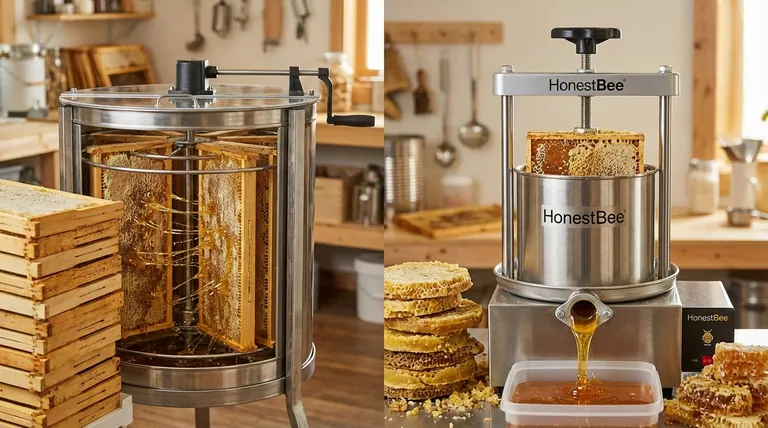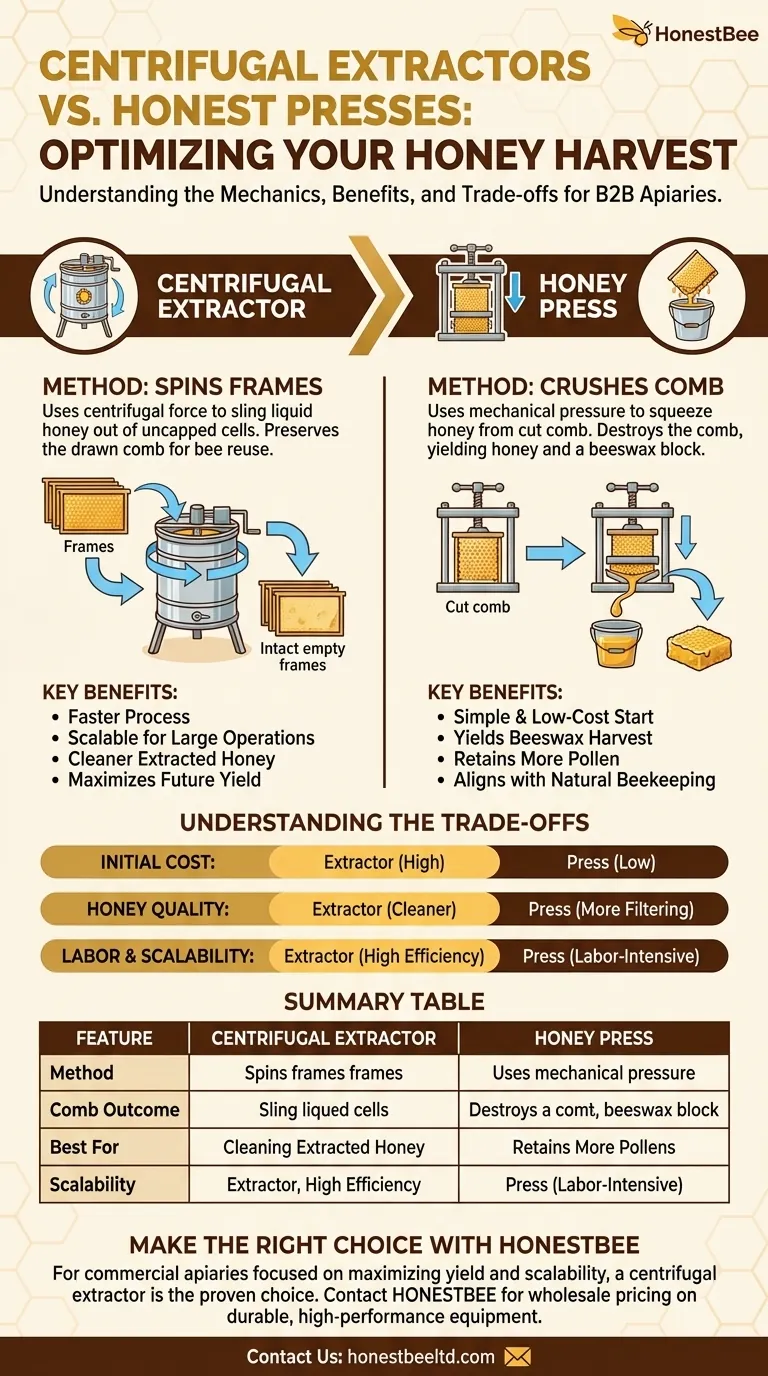The primary difference between a centrifugal extractor and a honey press lies in how they separate honey from the honeycomb. A centrifugal extractor spins frames to sling honey out using force, leaving the comb intact for the bees to reuse. In contrast, a honey press works by crushing the entire honeycomb, squeezing out both honey and beeswax together.
Your choice between these two methods is a fundamental decision that balances efficiency against simplicity. Centrifugal extraction prioritizes the preservation of comb to maximize future honey production, while pressing offers a lower-cost, simpler process that also yields a beeswax harvest.

The Mechanics of Centrifugal Extraction
A centrifugal extractor is the standard for most modern beekeepers, designed for speed and the preservation of hive resources.
How It Works: Centrifugal Force
An extractor is essentially a large drum with a mechanism to hold and spin honey frames. As the frames spin at high speed, centrifugal force slings the liquid honey out of the uncapped wax cells and onto the inner wall of the drum.
This process can be done tangentially (one side of the frame at a time) or radially (both sides at once), with radial extractors being more efficient for larger operations.
The Key Benefit: Preserving the Comb
The most significant advantage of extraction is that it preserves the drawn comb. Bees expend a tremendous amount of energy and resources to produce wax and build these intricate structures.
By returning the empty-but-intact combs to the hive, you give the bees a massive head start on the next honey flow. They can immediately begin refilling cells instead of spending weeks rebuilding the comb from scratch.
The Process Workflow
Before frames can be placed in an extractor, the beekeeper must first slice off the thin wax layer that seals the honey-filled cells. This is done with a heated or cold uncapping knife or a specialized scratching tool.
The Mechanics of a Honey Press
Honey pressing is a more rudimentary and forceful method, closely related to the traditional "crush and strain" technique used for centuries.
How It Works: Brute Force Compression
A honey press uses mechanical pressure to squeeze honey from the comb. The comb is cut from its frame and placed inside the press. A pressure plate or roller system then compacts the honeycomb, forcing the honey out through a filter or screen.
The most common design for hobbyists is a simple bucket press, which is effective and relatively inexpensive.
The Key Outcome: Honey and Beeswax
This method completely destroys the honeycomb. While you successfully extract the honey, you are left with a compressed block of beeswax.
For some beekeepers, this is a benefit. The beeswax can be rendered and used for candles, balms, or other products, providing a second harvest from the hive.
The Impact on Your Bees
Because the comb is destroyed, the bees must start over. They have to consume significant amounts of honey (roughly 8 pounds of honey to produce 1 pound of wax) to generate the wax needed to rebuild the entire structure of the hive. This can slow down subsequent honey production.
Understanding the Trade-offs
Neither method is universally superior; the right choice depends entirely on your goals, scale, and beekeeping philosophy.
Initial Investment Cost
A simple honey press or the components for a DIY "crush and strain" setup are significantly cheaper than a centrifugal extractor. Extractors, particularly motorized ones, represent a more substantial capital investment.
Honey Quality and Filtering
Extracted honey is generally cleaner from the start, containing only honey and trace amounts of wax from the uncapping process.
Pressed honey is mixed with a large volume of crushed wax particles and often more propolis. It requires more thorough filtering and straining to achieve clarity. Some proponents argue this method retains more pollen and natural elements from the comb.
Labor and Scalability
For anyone managing more than a few hives, a centrifugal extractor is far faster and less labor-intensive per pound of honey.
Pressing is a slower, batch-oriented process. While simple, it does not scale efficiently for larger apiaries.
Beekeeping Philosophy
Pressing aligns well with foundationless or "natural" beekeeping practices. It ensures the bees build fresh, new comb regularly, which some believe contributes to overall hive health by cycling out old comb.
Making the Right Choice for Your Apiary
To select the right equipment, consider what you want to optimize for your apiary.
- If your primary focus is maximizing honey yield and scalability: Choose a centrifugal extractor to preserve your drawn comb and accelerate future production cycles.
- If your primary focus is a low-cost start, simplicity, or natural beekeeping: A honey press is an excellent choice that also provides a valuable secondary harvest of beeswax.
- If you are a small-scale hobbyist with only one or two hives: The simplicity and low initial cost of pressing often make it the more practical and economical option.
Ultimately, your decision balances the long-term energy investment of your bees against the immediate financial investment in your equipment.
Summary Table:
| Feature | Centrifugal Extractor | Honey Press |
|---|---|---|
| Method | Spins frames; uses centrifugal force | Crushes comb; uses mechanical pressure |
| Comb Outcome | Preserved for bee reuse | Destroyed |
| Best For | Maximizing honey yield & scalability | Low-cost start, simplicity, beeswax harvest |
| Scalability | High (efficient for many hives) | Low (labor-intensive for large operations) |
Optimize Your Honey Harvest with the Right Equipment
Choosing between an extractor and a press is a critical decision that impacts your efficiency, costs, and long-term honey production. For commercial apiaries and distributors focused on maximizing yield, a centrifugal extractor from HONESTBEE is the proven choice for preserving valuable drawn comb and scaling your operation.
We supply durable, high-performance beekeeping equipment designed for wholesale and commercial use. Let our experts help you select the perfect extraction solution to boost your productivity.
Contact HONESTBEE today for wholesale pricing and expert advice tailored to your apiary's needs.
Visual Guide

Related Products
- 10L Stainless Steel Electric Honey Press Machine
- Stainless Steel Honey Press Wax Press with Tank
- Stainless Steel Manual Honey Press with Guard for Pressing Honey and Wax
- Honey Wax Separating Wax Press with Metal Screw Wax Separator Machine
- Electric Flatting and Embossing Machine with Tray for Beekeeping
People Also Ask
- What are the key features of a honey press? Maximize Yield with Durable, Efficient Extraction
- What are the unique characteristics of honey presses? Maximize Honey Yield for Small-Scale Beekeeping
- What are the benefits of using a honey press for Warré or Top Bar beehives? Maximize Your Natural Harvest
- What happens to the wax after pressing in a honey press? A Guide to Maximizing Your Hive's Yield
- How does the press method for extracting honey work? A Simple, Low-Cost Guide for Beekeepers



















